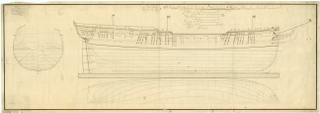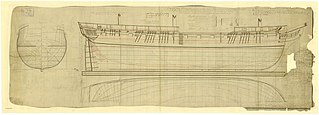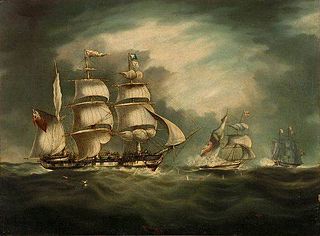Sir John Sherbrooke was a successful and famous Nova Scotian privateer brig during the War of 1812, the largest privateer from Atlantic Canada during the war. In addition to preying on American merchant ships, she also defended Nova Scotian waters during the war. After her conversion to a merchantman she fell prey to an American privateer in 1814. She was burnt to prevent her reuse.

HMS Bulwark was a 74-gun third-rate ship of the line of the Royal Navy, launched on 23 April 1807 at Portsmouth. She was designed by Sir William Rule as one of the large class 74s, and was the only ship built to her draught. She was built at Portsmouth Dockyard by Nicholas Diddams.

HMS Poictiers was a 74-gun Royal Navy third rate. This ship of the line was launched on 9 December 1809 at Upnor. During the War of 1812 she was part of the blockade of the United States. She was broken up in 1857.

HMS Acasta was a 40-gun Royal Navy fifth-rate frigate. She saw service in the French Revolutionary and Napoleonic Wars, as well as the War of 1812. Although she never took part in any notable single-ship actions nor saw action in a major battle though she was at the Battle of San Domingo, she captured numerous prizes and rid the seas of many Spanish, French and American privateers. She was finally broken up in 1821.

HMS Cerberus was a 32-gun fifth-rate frigate of the Royal Navy. She served in the French Revolutionary and the Napoleonic Wars in the Channel, the Mediterranean, the Adriatic, and even briefly in the Baltic against the Russians. She participated in one boat action that won for her crew a clasp to the Naval General Service Medal (NGSM). She also captured many privateers and merchant vessels. Her biggest battle was the Battle of Lissa, which won for her crew another clasp to the NGSM. She was sold in 1814.

HMS Havannah was a Royal Navy 36-gun fifth-rate frigate. She was launched in 1811 and was one of twenty-seven Apollo-class frigates. She was cut down to a 24-gun sixth rate in 1845, converted to a training ship in 1860, and sold for breaking up in 1905.

HMS Belle Poule was a Royal Navy fifth-rate frigate, formerly Belle Poule, a Virginie-class frigate of the French Navy that had been built by the Crucy family's shipyard at Basse-Indre to a design by Jacques-Noël Sané. She was launched on 17 April 1802, and saw active service in the East. In 1806 a British squadron under Sir John Borlase Warren captured her off La Palma in the Canary Islands. The Admiralty commissioned her into the Royal Navy as HMS Belle Poule. She was sold in 1816.
HMS Niemen was a Royal Navy 38-gun fifth-rate frigate. She began her career as the Niémen, a 44-gun French Navy Armide-class frigate, designed by Pierre Rolland. She was only in French service for a few months when in 1809 she encountered some British frigates. The British captured her and she continued in British service as Niemen. In British service she cruised in the Atlantic and North American waters, taking numerous small American prizes, some privateers but mostly merchantmen. She was broken up in 1815, at the end of the Napoleonic Wars and the War of 1812.
USS Rattlesnake was the brig Rambler built in Medford, Massachusetts, in 1812 that the United States Navy purchased in July 1813. Rattlesnake captured numerous British merchant vessels before HMS Leander captured her in mid-1814. The Royal Navy apparently purchased her at Nova Scotia, but there is no record of her subsequent career.

HMS Spartan was a Royal Navy 38-gun fifth-rate frigate, launched at Rochester in 1806. During the Napoleonic Wars she was active in the Adriatic and in the Ionian Islands. She then moved to the American coast during the War of 1812, where she captured a number of small vessels, including a US Revenue Cutter and a privateer, the Dart. She then returned to the Mediterranean, where she remained for a few years. She went on to serve off the American coast again, and in the Caribbean, before being broken up in 1822.
HMS Circe was a Royal Navy 32-gun fifth-rate frigate, built by Master Shipwright Joseph Tucker at Plymouth Dockyard, and launched in 1804. She served in the Caribbean during the Napoleonic Wars, and participated in an action and a campaign for which in 1847 in the Admiralty authorised the issuance of the Naval General Service Medal with clasps. The action, off the Pearl Rock, near Saint-Pierre, Martinique, was a debacle that cost Circe dearly. However, she also had some success in capturing privateers and a French brig. She was sold in 1814.

HMS Sophie was an 18-gun Cruizer class brig-sloop of the Royal Navy. She served during the Napoleonic Wars and the War of 1812. During the War of 1812 Sophie participated in the economic war against American trade, capturing or destroying numerous small merchant vessels, and in an unsuccessful attack on Fort Bowyer, Alabama. Later, she moved to the East Indies where she served in the First Anglo-Burmese War. The Admiralty sold Sophie in 1825.

HMS Epervier was an 18-gun Cruizer-class brig-sloop of the Royal Navy, built by Ross at Rochester, England, and launched on 2 December 1812. USS Peacock captured her in 1814 and took her into service. USS Epervier disappeared in 1815 while carrying dispatches reporting the signing of a treaty with the Dey of Algiers.

Rhin was a 40-gun Virginie-class frigate of the French Navy launched in 1802. She was present at two major battles while in French service. The Royal Navy captured her in 1806. Thereafter Rhin served until 1815 capturing numerous vessels. After the end of the Napoleonic Wars she was laid up and then served as a hospital for many years. She was finally broken up in 1884.

HMS Belette was an 18-gun Cruizer-class brig-sloop, built by King at Dover and launched on 21 March 1806. During the Napoleonic Wars she served with some success in the Baltic and the Caribbean. Belette was lost in the Kattegat in 1812 when she hit a rock off Læsø.

HMS Severn was an Endymion-class frigate of the British Royal Navy, launched in 1813 as one of five heavy frigates built to match the powerful American frigates. The shortage of oak meant that she was built of "fir", which meant a considerably shortened lifespan. Nonetheless, the ship saw useful service, especially at the bombardment of Algiers in 1816, before being broken up in 1825.
HMS Colibri was the French naval Curieux-class brig Colibri, launched in 1808, that the British captured in 1809 and took into the Royal Navy under her existing name. She spent her time in British service on the North American station based in Halifax, Nova Scotia. During the War of 1812, Colibri served mostly in blockading the American coast and capturing privateers and merchant ships. She foundered in 1813 in Port Royal Sound, South Carolina, but without loss of life.
HMS Paz was a Spanish naval schooner that the British Royal Navy captured at Monte Video on 3 February 1807. She served on the River Plate, North Sea, and North American Stations, where she captured numerous privateers and merchant vessels. The Navy sold her in 1816.
HMS Barbadoes was a 16-gun vessel, the American Herald, captured in 1813. The Royal Navy took her into service as HMS Barbadoes She captured a number of merchantmen and privateers before she was paid-off in May 1816. In 1814–1815 she also captured three Spanish and French slave ships carrying over 1100 enslaved people. Barbadoes became a powder ship in Jamaica that was later wrecked with her remains being sold.
HMS Cockchafer was a United States schooner, formerly named Spencer, that the Royal Navy (RN) captured and employed as a ship's tender. She captured two American armed brigs, one in a single-ship action. The Navy sold her in 1815.













